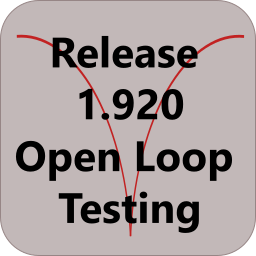
Release 1.920: Open Loop Testing
Share
Release 1.920 adds open loop testing. Open loop testing is useful when you are testing devices that cannot accept a stimulus from the audio analyzer. For example, there's no way to "drive" an MP3 player. The MP3 player can only render sound.
The solution in this case is to use a known stimulus saved as a WAV file. You can then load this WAV file onto the MP3 player or a USB drive, and play it out of whatever device you'd like to test.
Example
Let's say you were interesting in learning the frequency response of a PC DAC that you were evaluating. You could use PC Mirror mode on the QA401 and step through a series of tones, measuring the amplitude of the tones. Since the PC controls the DAC, and the QA401 software is running on the PC, that would be a straightforward task. But it would be time consuming. Let's take a look at how to do it quickly with a single chirp.
The first task is to compose the chirp. The sample rate of the DAC will be locked at 48 kHz--it's that roll off around 20 kHz we're particularly interested in. So, we'll want the QA401 in 192 kSps mode to ensure the DAC response isn't tempered by the analyzer response. And we'll use a 64K sized FFT. This will complete in well under a second.
Net, we need to consider the level. Let's start with a chirp at -10 dBFS.
Let's start by the putting the QA401 software into a known state: From the file menu, select "Reset Startup Defaults"
Next, change the sample rate (Settings->Options->General) to 192Ksps.
Then, select a 64K FFT size using the FFT control in the ACQ SETTINGS control group.
Switch to DBFS mode using the DBFS button in the AXIS SETTINGS control group. This allows us to specify the amplitude in dBFS, which is appropriate for a DAC.
Next, control+click on the FREQ RESPONSE button in the MEASUREMENTS control group. This will open the FR Settings dialog. Note the amplitude units is in dbFS. Set that to -10 dBFS.

We've now set everything needed to ensure we're in the mode we wanted:
- * 64K FFT size
- * -10 dBFS
- * 192 kSps sample rate
Now, go to the File->Export menu and select Export Chirp. Accept the default file name. The file will be exported to your MyDocs\QuantAsylum\QA401 folder.
The name of the file is
Chirp_Bd32f_Fs192_Le64k_Pb2k_Am-10.0dBFS.wav
Breaking this down, this is a chirp, with a bit depth of 32-bit, expressed as a float (+/-1.0 max), at a sample rate of 192K, with a length of 64K samples, with a pre-buffer of 2K, and at an amplitude of -10 dBFS.
It is very important your settings on the analyzer match the chirp!
We can now play that chirp using whatever WAV file player you prefer. Loading the WAV in Audacity shows the following (you could load the WAV file on your phone, car, too if that is your DUT).

In the plot above, you can roughly two regions. The first region is 10 mS of a 1 kHz sine, following by a sweep starting a low frequencies and rising to very high frequencies. The purpose of the 1 kHz sine in the beggining is to allow the QA401 to trigger. The captured 10 mS of sine will be thrown away, and the analysis will be done on the remaining sweep.
Capturing the WAV
With the WAV loaded and ready to play, you need to tell the analyzer software to get ready to capture. An additional button has been added to the Run/Stop control group:

Pressing the "Open Loop Acq" button bring up a dialog. This dialog will show the left channel streaming data in real time. The capturing will start when the threshold (-35 dBFS in the plot below) is exceeded. Make your you are in the +6 dBV input range if appropriate. Otherwise, you will need a much stronger signal to trigger the acquisition.

Before capturing the signal, make sure you are in the Freq Response mode by pressing the Freq Response button in the MEASUREMENTS control group.
Now, play the WAV file you exported above on your DUT. If the captured signal exceeds the threshold, the resulting spectrum will be displayed. Note the flat passband, and the sharp rolloff after 20 kHz. Since we're in 192k sample rate on the analyzer, and the DAC is locked to 48k, we can be sure this rolloff is due to the DAC and whatever transcoding Windows/Audacity is doing.

Next, open the graphic EQ in Audacity and notch out 1 kHz:

"Preview" the notch while capturing on the QA401 again. Here we see the 1kHz notch appears in the spectrum:

The chirps above about about 0.25 seconds in duration, making the characterization very fast.
Moving the WAV to an Android phone and playing back with Foobar2000 yields a similar response:

Summary
Open Loop testing can be very useful for looking at the frequency response of a DUT that doesn't have an analog input readily accessible. The release should post in the next few days.
